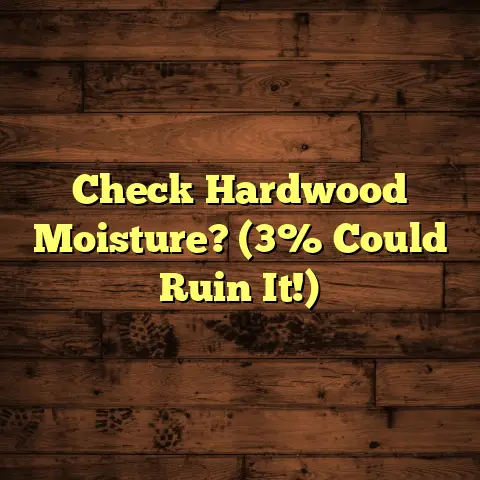Remove Paint From Laminate? (4 Risky Ways!)
Ever notice how home decor is all about layering?
We layer rugs on floors, art on walls, and textures throughout a room to create depth and interest.
Laminate flooring, with its budget- friendly appeal and realistic wood or tile look, is a popular choice.
But let’s be honest, sometimes it becomes the unintended canvas for paint splatters!
(Been there, cleaned that, right?)
While laminate mimics pricier materials, it needs special care, especially when removing stubborn substances like paint.
Getting rid of that unwanted color can be tricky, and some methods?
Well, they’re downright risky.
Today, I’m diving into four methods that can remove paint from laminate.
But trust me, you’ll want to proceed with caution!
Understanding Laminate Flooring
So, what is laminate flooring anyway?
It’s basically a multi-layer synthetic flooring product fused together through a lamination process.
Think of it as a high-tech, super-durable photograph of wood, tile, or stone.
It typically consists of these layers:
-
Wear Layer: The top, transparent layer that protects against scratches, stains, and fading.
-
Decorative Layer: A high-resolution photographic image that gives the laminate its realistic look.
-
Core Board: Usually made of high-density fiberboard (HDF) or medium-density fiberboard (MDF), providing stability and impact resistance.
-
Backing Layer: A moisture-resistant layer that protects the core from water damage.
Laminate’s versatility makes it a winner in many homes.
I see it everywhere, from bustling kitchens and cozy living rooms to serene bedrooms.
Why?
It’s durable, easy to clean (usually!), and more affordable than hardwood or tile.
Plus, the installation process is usually pretty straightforward, which is a big plus for DIYers like us!
Why Paint on Laminate is a Problem
Okay, so you’ve got paint on your laminate.
How did it get there?
Well, life happens!
Maybe you were tackling a room makeover, and a stray brush decided to “redecorate” the floor.
Or perhaps a can of paint took an unexpected tumble.
Heck, I even had a client who’s kid thought the floor needed a mural!
Whatever the reason, paint on laminate is a problem for a few reasons:
-
Discoloration: Paint can stain the laminate, especially if it’s left for a long time.
-
Peeling: Dried paint can chip and peel, making your floor look worn and neglected.
-
Finish Damage: Some paint removers can strip the protective wear layer of the laminate, leaving it vulnerable to scratches and stains.
-
Aesthetic Nightmare: Let’s face it, nobody wants splotches of paint messing up their floor’s vibe.
Ignoring paint spills can lead to bigger, more expensive problems down the road.
That’s why it’s crucial to address them promptly and carefully.
But how?
Let’s get into those risky methods…
Risky Method #1: Using Acetone or
Nail Polish Remover
Acetone, the star ingredient in nail polish remover, is a powerful solvent.
It can break down many types of paint, making it a tempting option for paint removal from laminate.
How it Works:
Acetone works by dissolving the paint’s binders, the substances that hold the pigment particles together.
This weakens the paint’s adhesion to the laminate surface, making it easier to lift off.
The Process:
-
Gather Your Supplies: You’ll need:
-
Acetone or nail polish remover (ensure it contains acetone).
-
Cotton balls or soft rags.
-
Clean water.
-
A clean, dry cloth.
-
Gloves (to protect your skin).
-
Eye protection (safety first!).
-
-
Test in an Inconspicuous Area: Before going all-in, test the acetone on a hidden spot of the laminate (like under a rug or in a closet).
This helps you see if it will damage or discolor the finish.
Wait at least 30 minutes to observe any adverse effects.
-
Apply Acetone: Dip a cotton ball or rag into the acetone.
Gently dab or blot the paint stain.
Avoid rubbing vigorously, as this can spread the paint or damage the laminate.
-
Let it Sit (Briefly): Allow the acetone to sit on the paint for a few seconds to soften it.
Don’t let it sit for too long, as prolonged exposure can harm the laminate.
-
Wipe Away: Use a clean part of the rag to gently wipe away the softened paint.
Repeat steps 3 and 4 as needed until the paint is gone.
-
Rinse with Water: Once the paint is removed, dampen a clean cloth with water and wipe the area to remove any acetone residue.
-
Dry Thoroughly: Use a dry cloth to thoroughly dry the area.
The Risks:
-
Finish Damage: Acetone is a strong solvent and can dissolve the laminate’s wear layer, leading to dullness or scratches.
-
Discoloration: Acetone can sometimes cause discoloration, especially on darker laminates.
-
Fumes: Acetone fumes can be irritating to the eyes and respiratory system.
Always work in a well-ventilated area.
-
Flammability: Acetone is highly flammable.
Keep it away from heat, sparks, and open flames.
Personal Experience:
I once used acetone to remove a small paint splatter from a client’s laminate floor.
While it worked, I noticed a slight dulling of the finish in that area.
I had to use a laminate floor restorer to bring back the shine.
Lesson learned:
Less is more with acetone!
Risky Method #2: Heat Gun Application
A heat gun, usually used for stripping paint or thawing pipes, can also soften paint on laminate for easier removal.
How it Works:
Heat guns emit a concentrated stream of hot air.
This heat softens the paint, making it more pliable and easier to scrape or wipe away.
The Process:
-
Gather Your Supplies: You’ll need:
-
A heat gun with adjustable settings.
-
A plastic scraper.
-
A clean, soft cloth.
-
Gloves.
-
Eye protection.
-
-
Test in an Inconspicuous Area: Just like with acetone, test the heat gun on a hidden area first.
Hold the heat gun about 6-8 inches away from the surface and apply heat for a few seconds.
Check for any signs of damage, such as warping or discoloration.
-
Apply Heat: Hold the heat gun about 6-8 inches away from the paint stain.
Use a low heat setting and move the gun back and forth to distribute the heat evenly.
Avoid concentrating the heat on one spot for too long.
-
Scrape Gently: As the paint softens, use a plastic scraper to gently lift it away from the laminate surface.
Work in small sections and avoid applying too much pressure.
-
Wipe Away Residue: Use a clean, soft cloth to wipe away any remaining paint residue.
-
Cool Down: Allow the area to cool completely.
The Risks:
-
Melting Laminate: Excessive heat can melt the laminate’s plastic components, causing irreversible damage.
-
Warping: High heat can warp the laminate, creating an uneven surface.
-
Discoloration: Heat can cause the laminate’s finish to discolor or fade.
-
Fire Hazard: Heat guns can ignite flammable materials.
Be extra cautious when working near curtains, rugs, or other combustibles.
Industry Insights:
According to the North American Laminate Flooring Association (NALFA), extreme heat can compromise the structural integrity of laminate flooring.
They recommend avoiding heat guns altogether and opting for safer paint removal methods.
Personal Story:
I once tried using a heat gun to remove some stubborn paint from a laminate countertop (similar material, right?).
I got impatient and held the heat gun too close for too long.
The laminate bubbled up and warped!
It was a costly mistake, and I ended up having to replace the entire countertop.
Trust me, patience is key with this method!
Risky Method #3: Paint Thinner or
Solvent Use
Paint thinner and other solvents are designed to dissolve paint.
They can be effective at removing paint from laminate, but they also pose some serious risks.
How it Works:
Paint thinners contain powerful solvents that break down the chemical bonds in paint, causing it to liquefy and detach from the surface.
The Process:
-
Gather Your Supplies: You’ll need:
-
Paint thinner or solvent (choose one specifically designed for the type of paint you’re removing).
-
Soft rags.
-
Clean water.
-
A clean, dry cloth.
-
Gloves (chemical-resistant).
-
Eye protection (chemical-resistant).
-
A respirator or face mask (to protect against fumes).
-
-
Ventilation is Key: Work in a well- ventilated area.
Open windows and doors, and use a fan to circulate air.
-
Test in an Inconspicuous Area: As always, test the paint thinner on a hidden area first.
Apply a small amount to a rag and gently dab it on the test spot.
Wait at least 30 minutes to check for damage or discoloration.
-
Apply Paint Thinner: Dampen a rag with paint thinner.
Gently blot the paint stain, working from the outside in.
Avoid rubbing, as this can spread the paint.
-
Let it Sit (Briefly): Allow the paint thinner to sit on the paint for a few seconds to soften it.
Don’t let it sit for too long, as it can damage the laminate.
-
Wipe Away: Use a clean part of the rag to gently wipe away the softened paint.
Repeat steps 4 and 5 as needed.
-
Rinse with Water: Once the paint is removed, dampen a clean cloth with water and wipe the area to remove any paint thinner residue.
-
Dry Thoroughly: Use a dry cloth to thoroughly dry the area.
The Risks:
-
Laminate Damage: Paint thinners can dissolve the laminate’s wear layer and damage the core board.
-
Chemical Odors: Paint thinners have strong, lingering odors that can be unpleasant and even harmful.
-
Health Hazards: Paint thinner fumes can cause respiratory irritation, headaches, dizziness, and nausea.
Prolonged exposure can lead to more serious health problems.
-
Flammability: Paint thinners are highly flammable.
Keep them away from heat, sparks, and open flames.
Safety First:
The Occupational Safety and Health Administration (OSHA) provides detailed guidelines for working with paint thinners and other solvents.
Always follow these guidelines to protect yourself from chemical exposure.
My Advice:
I generally avoid using paint thinners on laminate unless absolutely necessary.
The risks are simply too high.
If you must use them, proceed with extreme caution and prioritize safety above all else.
Risky Method #4: Sanding Down the Paint
Sanding involves using abrasive materials to physically remove the paint from the laminate surface.
How it Works:
Sandpaper, with its rough texture, grinds away the paint layer by layer.
The Process:
-
Gather Your Supplies: You’ll need:
-
Fine-grit sandpaper (220-grit or higher).
-
A sanding block or orbital sander (optional).
-
A vacuum cleaner with a brush attachment.
-
A clean, damp cloth.
-
A clean, dry cloth.
-
Dust mask.
-
Eye protection.
-
-
Prepare the Area: Cover surrounding surfaces with drop cloths to protect them from dust.
-
Sand Gently: Wrap the sandpaper around a sanding block or attach it to an orbital sander.
Apply light pressure and sand the paint in a circular motion.
Avoid sanding too aggressively, as this can damage the laminate.
-
Vacuum Frequently: Use a vacuum cleaner with a brush attachment to remove dust from the surface as you sand.
This will help you see your progress and prevent the sandpaper from clogging.
-
Wipe Clean: Once the paint is removed, wipe the area with a damp cloth to remove any remaining dust.
-
Dry Thoroughly: Use a dry cloth to thoroughly dry the area.
The Risks:
-
Scratching: Sanding can easily scratch the laminate’s wear layer, leaving permanent marks.
-
Uneven Surface: Sanding too much in one area can create an uneven surface.
-
Dust Exposure: Sanding generates fine dust particles that can be harmful to your respiratory system.
-
Finish Damage: Sanding can remove the laminate’s finish, leaving it dull and vulnerable to stains.
Expert Tip:
If you’re using an orbital sander, start with the lowest speed setting and gradually increase it as needed.
Avoid applying too much pressure, and keep the sander moving at all times.
My Experience:
I once tried sanding a small scratch on a laminate floor.
Even with the finest-grit sandpaper, I ended up making the scratch worse!
The sanding created a noticeable dull spot that was impossible to fix.
I learned that sanding laminate is almost always a bad idea.
Conclusion
So, there you have it: four risky methods for removing paint from laminate flooring.
We talked about using:
- Acetone
- Heat Guns
- Paint Thinners
- Sanding
While these methods can be effective, they all come with significant risks.
You could end up damaging your laminate even more than the paint did!
Before you reach for that acetone, heat gun, or sandpaper, take a deep breath and consider all your options.
Maybe a gentler approach, like a specialized laminate cleaner, is worth a try first.
And if you’re not confident in your DIY skills, don’t hesitate to call a professional.
Sometimes, it’s better to be safe than sorry (and end up with a ruined floor!).
Good luck, and happy (and safe!) cleaning!





